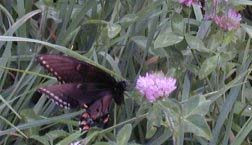Pasture diversity and management
Dr. Sarah Goslee, USDA ARS Pasture Systems and Watershed Management
Research Unit
Background¶
There are 120 million acres of pasture in the United States, along with 406 million acres of rangeland and 62 million acres of hay. These grazing and forage crops contribute to more than \$80 billion in yearly farm sales. On the farm, pastures can lower feed and energy costs and improve livestock health. Regionally, permanent grasslands reduce soil erosion and nutrient losses, and provide open space for wildlife and bird habitat.
Despite the importance of pastures, not much is known about their ecology. We have been studying the diversity and composition of pastures, and how that contributes to:
- Productivity of both plants and grazing animals.
- Stability of pasture production under stress (for example drought).
- Ability of pastures to recover after stress.
This fact sheet will focus on what we have learned about pasture diversity and pasture monitoring.
Regional Survey¶
From 1998 to 2005, we surveyed 44 farms from Maryland to Maine. All farms had grazing animals, usually dairy cows. In 2-8 pastures on each farm, we collected information on plant species number and total cover, bare ground, and number and cover of each species present. We made complete species lists for a 0.25 acre area (1000 m2), and estimated species cover in ten smaller quadrats (11 ft2, or 1 m2) within the larger plot.
We also collected soil test results, slope, elevation and aspect (for example, north- or south -facing) for each pasture, and annual precipitation and temperature for each farm.
[
Pasture Diversity and Composition¶
Northeastern pastures are very diverse. We found 310 species of plants. The average number of plant species in a pasture was 32, but we found anywhere from 9 to 73. Nearly half of the species identified were native. Most species were rare, but some were common and abundant. Many of these were forage species, such as orchardgrass, Kentucky bluegrass, tall fescue, timothy and red and white clovers. Other common species included quackgrass, English and common plantains, curly dock and dandelion.
The average pasture:
- has 32 species.
- has 6% bare ground.
- has 67% grass cover.
- has 21% legume cover.
- has 23% broadleaf cover.
Pasture Condition Score¶
The NRCS has developed a pasture monitoring method called the Pasture Condition Score. It uses ten criteria, each ranked on a scale of 1 (major effort required) to 5 (no change needed):
- Percent desirable plants: Plants that livestock will graze readily
- Plant cover: Important to forage production, soil and water protection
- Plant residue: Amount of standing dead, litter, and thatch
- Plant diversity: Number of different forage plants well represented
- Plant vigor: Indicates health of desirable species
- Legume content: Source of N, improves forage quality
- Uniformity of use: Indicates “spot” grazed, over grazed, avoided areas
- Livestock concentration areas: Indicates where livestock congregate and potentially damage pastures
- Erosion: Presence, severity of wind, water erosion
- Soil compaction: Indicator of impaired water infiltration capacity
The ten criteria are added, for a score ranging from 10 to 50. More information can be found in the “Guide to Pasture Condition Scoring.”
Pasture Monitoring¶
As part of the regional survey, we recorded 182 pasture conditions scores. Only 1% of the pastures were very high-scoring, but most of the pastures needed only minor or moderate changes. None of the pastures we sampled scored in the lowest category.
Pastures scored lowest in two areas, plant diversity and legume content. Manipulating plant diversity would improve the pasture condition score for many of these farms. The lowest-scoring pastures were rated poorly for plant cover, uniformity of use and soil compaction, and generally lower for all criteria. Changes in grazing management, to reduce under- and over-use, could improve the ratings of these pastures.
Future Work¶
We are working to understand how the complex mixtures of planted and unplanted species found in Northeastern pastures contribute to pasture production and forage quality. Manipulating species diversity and content would improve the pasture condition score rankings of many pastures in the Northeast. We are investigating the benefits and drawbacks of forage mixtures containing grasses, legumes and broadleaf plants. The next step will be to identify effective methods for establishing and maintaining the most useful of these mixtures on a range of site types.